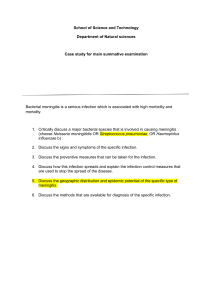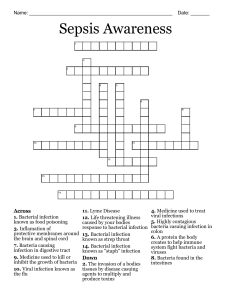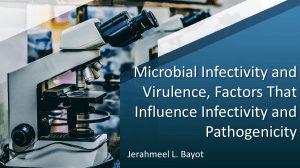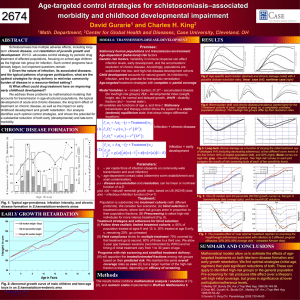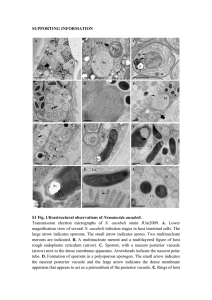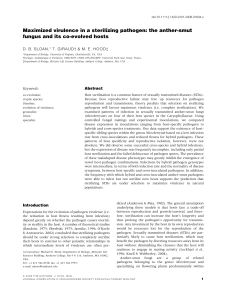2420 review III exam.doc
advertisement
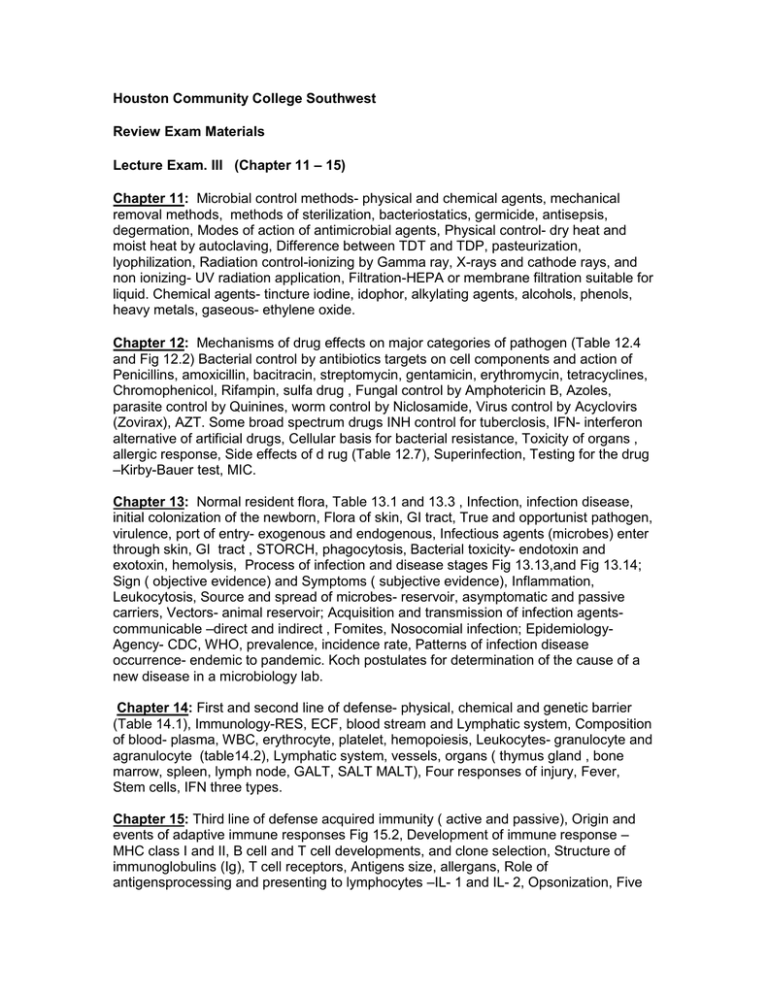
Houston Community College Southwest Review Exam Materials Lecture Exam. III (Chapter 11 – 15) Chapter 11: Microbial control methods- physical and chemical agents, mechanical removal methods, methods of sterilization, bacteriostatics, germicide, antisepsis, degermation, Modes of action of antimicrobial agents, Physical control- dry heat and moist heat by autoclaving, Difference between TDT and TDP, pasteurization, lyophilization, Radiation control-ionizing by Gamma ray, X-rays and cathode rays, and non ionizing- UV radiation application, Filtration-HEPA or membrane filtration suitable for liquid. Chemical agents- tincture iodine, idophor, alkylating agents, alcohols, phenols, heavy metals, gaseous- ethylene oxide. Chapter 12: Mechanisms of drug effects on major categories of pathogen (Table 12.4 and Fig 12.2) Bacterial control by antibiotics targets on cell components and action of Penicillins, amoxicillin, bacitracin, streptomycin, gentamicin, erythromycin, tetracyclines, Chromophenicol, Rifampin, sulfa drug , Fungal control by Amphotericin B, Azoles, parasite control by Quinines, worm control by Niclosamide, Virus control by Acyclovirs (Zovirax), AZT. Some broad spectrum drugs INH control for tuberclosis, IFN- interferon alternative of artificial drugs, Cellular basis for bacterial resistance, Toxicity of organs , allergic response, Side effects of d rug (Table 12.7), Superinfection, Testing for the drug –Kirby-Bauer test, MIC. Chapter 13: Normal resident flora, Table 13.1 and 13.3 , Infection, infection disease, initial colonization of the newborn, Flora of skin, GI tract, True and opportunist pathogen, virulence, port of entry- exogenous and endogenous, Infectious agents (microbes) enter through skin, GI tract , STORCH, phagocytosis, Bacterial toxicity- endotoxin and exotoxin, hemolysis, Process of infection and disease stages Fig 13.13,and Fig 13.14; Sign ( objective evidence) and Symptoms ( subjective evidence), Inflammation, Leukocytosis, Source and spread of microbes- reservoir, asymptomatic and passive carriers, Vectors- animal reservoir; Acquisition and transmission of infection agentscommunicable –direct and indirect , Fomites, Nosocomial infection; EpidemiologyAgency- CDC, WHO, prevalence, incidence rate, Patterns of infection disease occurrence- endemic to pandemic. Koch postulates for determination of the cause of a new disease in a microbiology lab. Chapter 14: First and second line of defense- physical, chemical and genetic barrier (Table 14.1), Immunology-RES, ECF, blood stream and Lymphatic system, Composition of blood- plasma, WBC, erythrocyte, platelet, hemopoiesis, Leukocytes- granulocyte and agranulocyte (table14.2), Lymphatic system, vessels, organs ( thymus gland , bone marrow, spleen, lymph node, GALT, SALT MALT), Four responses of injury, Fever, Stem cells, IFN three types. Chapter 15: Third line of defense acquired immunity ( active and passive), Origin and events of adaptive immune responses Fig 15.2, Development of immune response – MHC class I and II, B cell and T cell developments, and clone selection, Structure of immunoglobulins (Ig), T cell receptors, Antigens size, allergans, Role of antigensprocessing and presenting to lymphocytes –IL- 1 and IL- 2, Opsonization, Five class of Ig – IgG, IgA, IgM, IgD and IgE (table 15.2) , Antibodies in serum its four bands and presence of antibody in serum, Monoclonal antibody, Hybridoma cells, T helper and T cytotoxic and Natural killer cells, Apoptosis, Antigen presenting cells ( APC), Immunization and vaccination.


